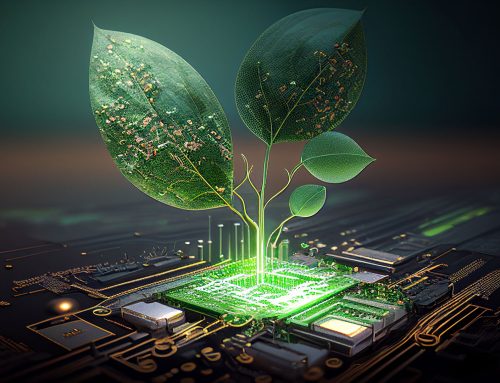The rapid pace of technological evolution presents a formidable challenge for companies across various business domains, encompassing security, finance, and human resources.
Those reluctant to embrace this transformative wave run the risk of being left behind, while forward-thinking organizations must commit substantial investments in their resources to not only stay ahead of the competition but also to position themselves as the preferred choice for their discerning customer base.
In the forthcoming blog, we will delve into the six paramount technological trends that companies should strategically leverage to ensure a prosperous 2024 and beyond.
The Top 6 Tech Trends for 2024
In the midst of the digital era, we find ourselves amidst a continuous stream of breakthroughs, each one more transformative than the last. The best way to handle these changes is not just to accept them but to really understand them from the ground up.
With more than ten years of experience and by working closely with big companies regularly, Eurisko is well-placed to spot trends and offer advice on the best ways of doing things. Our office in Silicon Valley adds to our ability to stay on top of what’s happening in the tech world.
The top 6 tech trends for 2024
Generative AI (GenAI)
Generative AI, propelled into the spotlight by the buzz surrounding ChatGPT, has likely become a familiar concept for many companies. But why is it the leading trend in 2024?
Generative AI, or GenAI, is a subset of artificial intelligence focused on machines creating new content, whether it’s text, images, music, or other media forms. At its core, this technology excels in learning patterns, styles, and structures from existing data and subsequently generating content that either replicates or builds upon these learned patterns.
Here are the key reasons why every business should consider embracing generative AI
Automated Content Creation
The adoption of automated content creation results in the generation of a higher quantity and improved quality of content within shorter timeframes. This efficiency translates to reduced labor costs, allowing marketing departments to operate more productively with optimized budgets.
In fields like design, architecture, and product development, generative AI tools play a pivotal role by offering inspiration and fresh perspectives. This, in turn, fosters innovation within businesses operating in these sectors.
Increased Efficiency in Research & Development
In sectors such as pharmaceuticals and materials science, generative AI plays a crucial role in expediting the research and development process. By efficiently analyzing extensive datasets and suggesting potential solutions, it speeds up the discovery of new drugs, materials, or formulations. This heightened efficiency not only contributes to a faster time-to-market but also provides a competitive advantage.
Personalized Customer Experience
Generative AI plays a pivotal role in shaping personalized customer experiences through the analysis of customer data, enabling tailored content and recommendations. In the realm of e-commerce, businesses leverage generative models to craft personalized product recommendations, elevating customer engagement and satisfaction.
Across diverse sectors such as banking, finance, travel, events, and education, AI-powered chatbots emerge as formidable conversational tools. These chatbots adeptly address queries, furnish information, calculate financial plans, and handle complaints, all without the need for human intervention.
Optimized Decision-Making
Generative AI proves instrumental in optimizing decision-making processes by offering data-driven insights and recommendations. In sectors like finance, where robust data analysis is paramount, these models excel in scrutinizing market trends, evaluating risks, and suggesting investment strategies. Businesses, armed with the discerning outputs of generative AI, can make more informed decisions, thereby contributing to overall operational excellence.
Spatial Computing & Industrial Metaverse
Spatial Computing involves the integration of digital information into the physical world, creating immersive and interactive experiences. It incorporates augmented reality (AR) and virtual reality (VR) technologies to enhance the human’s perception of the surrounding environment.
On the other hand, the Industrial Metaverse extends this concept to industrial settings, creating a virtual space where physical and digital elements seamlessly coexist. This interconnected digital ecosystem allows for the simulation and optimization of real-world scenarios, fostering innovation in training, work processes, and collaboration.
The Business Benefits of Spatial Computing and Industrial Metaverse:
| Technology | Benefit | Example |
| Spatial Computing | Enhanced Training and Skill Development in life-like virtual environment | In healthcare, surgeons can practice complex procedures in a simulated environment, improving their skills and decision-making. |
| Improved Collaboration
Between Teams Members. |
Architects and designers can collaborate in real-time on 3D models, making instant modifications and decisions to optimize the design process. | |
| Remote Work Facilitation | Teams distributed across different locations can meet in a virtual boardroom, enhancing communication and collaboration. | |
| Data Visualization and Analysis | Data scientists can use immersive visualizations to explore and understand intricate patterns in large datasets, leading to more informed insights. | |
| Industrial Metaverse | Virtual Prototyping and Simulation
(reducing the need for physical prototypes) |
Automotive companies can simulate the performance of a new vehicle design, optimizing aerodynamics and fuel efficiency before physical production. |
| Remote Maintenance and Troubleshooting | A field technician, guided by augmented reality (AR) instructions, can remotely diagnose and fix issues in a manufacturing plant. | |
| Efficient Supply Chain Management
(By providing real-time visibility into the movement of goods and materials) |
Logistics managers can use AR overlays to track shipments, manage inventory levels, and identify potential bottlenecks in the supply chain. | |
| Increased Safety and Risk Mitigation in The Workplace | Oil and gas companies can use VR simulations to train employees on emergency response procedures in the event of a plant malfunction. | |
| Predictive Maintenance and Asset Optimization
(It integrates with IoT sensors) |
Manufacturers can use real-time data from sensors to predict when machinery needs maintenance, minimizing downtime and maximizing efficiency. |
IoT & Datafication
Internet of Things (IoT) and datafication, intertwine to reshape the landscape of connectivity and intelligence. IoT, is a network of smart devices that spans from homes to vast industrial landscapes, each embedded with sensors and software actively generating a constant stream of data, breathing life into the concept of datafication.
Smart devices act as data conduits, translating the physical world into a language of bits and bytes. This inherent connection between IoT and datafication marks a fundamental shift, turning the mundane into the measurable and the everyday into the analyzable.
The process of converting real-world activities, behaviors, and environmental phenomena into digital data gains depth and precision with the continuous influx of information from IoT devices.
3 top benefits from IoT and datafication
| The Benefit | IoT | Datafication |
| Informed Decision-Making | IoT devices continuously generate vast amounts of real-time data from various sources, providing a comprehensive view of processes, environments, and user behaviors. | By integrating IoT-generated data into broader datafication processes, organizations can derive valuable insights. This wealth of information enables more informed decision-making across various domains. |
| Operational Efficiency & Optimization | IoT devices facilitate the monitoring and control of physical assets, machinery, and systems. This leads to improved operational efficiency, as organizations can remotely manage and optimize processes based on real-time data. | Integrating IoT data into datafication processes allows for a deeper understanding of operational patterns. This, in turn, enables organizations to identify areas for improvement, predict maintenance needs, and streamline workflows, ultimately enhancing overall operational efficiency. |
| Enhanced Customer Experience | IoT devices in retail, healthcare, and other sectors gather data on customer behaviors, preferences, and interactions. This information helps businesses tailor products and services to meet individual needs. | Integrating IoT-generated data into the broader datafication framework enables organizations to create personalized customer experiences. Whether through targeted marketing, customized product recommendations, or improved service delivery. |
The Zero Trust Model
Unlike traditional security approaches that rely on perimeter defenses, the Zero Trust model operates under the assumption that no entity, whether internal or external, should be trusted by default. Every user, device, and application is treated as untrusted, requiring continuous verification and authentication throughout the entire network.
The Zero-Trust model involves a comprehensive reassessment of access controls, where Authentication becomes a continuous process that adapts to user behavior and contextual information.
One pivotal component of the Zero-Trust model is the Biometrics identification, which leverages unique physical or behavioral characteristics to authenticate and verify individuals. This can include fingerprints, facial recognition, iris scans, voice patterns, and even typing dynamics. Unlike traditional password-based systems, biometrics offer a higher level of security and convenience.
This shift from a perimeter-based to a data-centric security strategy ensures a robust defense against the sophisticated cyber threats of the digital age.
Why Those Trends?
Technology, in essence, isn’t an end goal; rather, it’s the underlying purpose that demands our focus and encourages us to invest our resources in that direction. In 2024, both businesses and international organizations (IGOs) are actively championing digital responsibility and emphasizing the associated benefits.
Sustainability & Sustainable Technology
As we approach the year 2030, the deadline set by the United Nations to accomplish its 17 Sustainable Development Goals, there is an increasing onus on businesses and organizations to embrace sustainable technologies in both production and consumption.
These technologies encompass innovative solutions to environmental challenges, such as carbon capture and storage, green cloud computing emphasizing reduced energy consumption and carbon emissions, and the development of sustainable applications. The collective adoption of such solutions points towards the realization of smarter and more sustainable cities.
Cyber Resilience & Security
In an era marked by increased technology adoption and internet connectivity, individuals and entities must elevate their awareness of cybercrimes and fortify themselves against potential cyber attacks. Studies reveal that one out of every two companies has fallen victim to a cyberattack in the past three years, and if this trend persists, it could lead to a staggering cost of around $10 trillion for businesses by the close of 2024.
However, cyber resilience transcends mere cybersecurity. It encompasses proactive measures aimed at recovery and ensuring business continuity in the aftermath of breaches or circumstances beyond our control. This might involve implementing remote working protocols to ensure business functionality in situations where staff cannot access central locations – a technological solution that may not conventionally be considered a component of cybersecurity.
Conclusion
As we wrap up our exploration of the top tech trends for companies in 2024, the significance of embracing innovation becomes crystal clear. From the creative synergy of Generative AI to the security fortifications of Zero Trust Models, businesses that adapt to these trends will not only survive but thrive in the digital landscape. The journey may be challenging, but the rewards are boundless.




